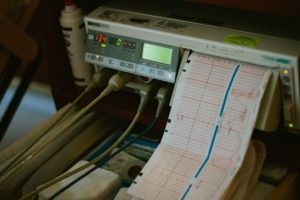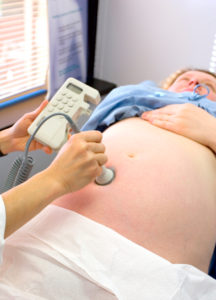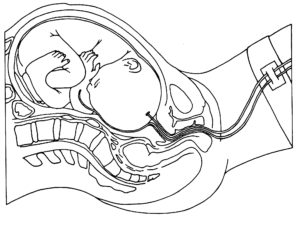While labour is a normal process, it is also unpredictable. During labour and birth, your caregiver may need to recommend one or more medical procedures to help you or your baby. We’ve outlined the benefits and risks of the more common procedures below. When you are in labour it may be difficult to focus on the explanations, so ask your caregiver early in your pregnancy to explain these and other procedures that you may need.
Fetal Monitoring
The baby’s heart-rate is monitored throughout active labour and pushing or at any other time there is a concern. This can be done using external monitoring using a handheld Doppler or with electrodes held in place with belts or internally using an electrode that is attached directly to the baby. The type of monitoring can vary depending on medical conditions, medications being used and stage of labour. Typically most people are monitored intermittently; this allows for more movement during labour. Even with continuous monitoring, labouring people are often still able to use upright positions and the birth ball.
External
- Two belts with sensors are placed around your abdomen. One sensor measures your baby’s heart rate, the other measures your contractions. The measurements are printed on to a graph that your caregivers use to assess your labour and how your baby is reacting to it. This can be done in many positions in the bed, on the birth ball or in a chair. This type of monitoring can be done using either equipment that is wireless, known as telemetry, or with electrodes that are attached with wires directly to the monitor.


- Your caregiver can listen to your baby’s heart rate periodically throughout your labor using a doppler or a fetoscope. The doppler can be used in the shower.

Internal
- Internal fetal monitoring may be used if there is a concern about the baby’s health or if your caregivers are unable to get an accurate reading with the external fetal monitor. This is a more accurate way of listening to the baby’s heart rate.
- A small electrode is attached to the baby’s scalp by a very thin wire. The electrode is applied through the vagina, after the cervix has opened and the amniotic sac (bag of waters) has broken
- If the bag of waters haven’t already ruptured then the caregiver will break them
- Once the bag of waters have broken there is an increased risk of infection to the parent and the baby
- The contractions may feel stronger; this may lead to further interventions
- Internal monitoring does not cause discomfort to the labouring person, other than needing to lie still while the procedure is being done
- Mobility will be limited
- The baby may have some bruising and a small scab where the wire was attached
